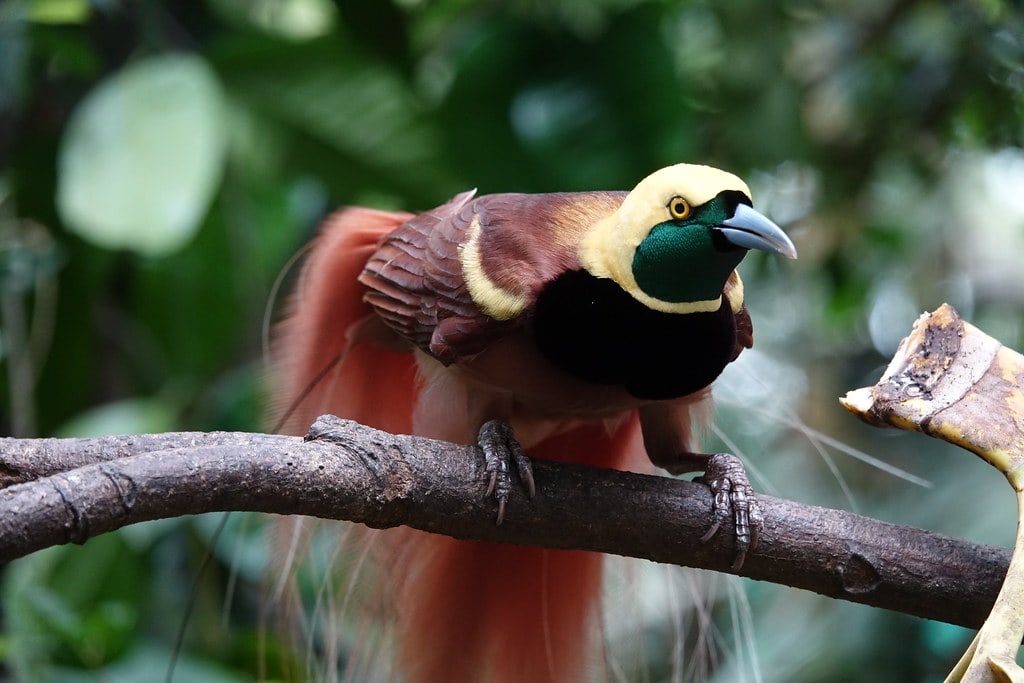The name says it all, Birds-of-Paradise are colourful, exotic creatures that have been considered a direct gift from God and the heavens. They have been sought after for centuries because of their iridescent colour schemes and extravagantly long feathers that have been used decoratively and ceremonially by various cultures. These birds have been used to symbolise power – especially in competition, bravery and invulnerability, affluence, and even sexuality and fertility. People who connect with the Birds-of-Paradise are at home in the spotlight and naturally draw attention to themselves with their attractiveness and outspoken nature – as the birds themselves do so with their enchanting dance rituals.
A Bird-of-Paradise is actually any one of the 45 species (1) within the Family Paradisaeidae which come under the Order Passeriformes – the perching birds or songbirds. They are small to medium-sized birds that can only be found in the dense tropical forests of Eastern Indonesia, Papua New Guinea and surrounding islands as well as in far northeastern Australia. Of all the species, the undeniable homeland of the Birds-of-Paradise, with 38 of these species being found on the island of New Guinea, many exclusively (2).
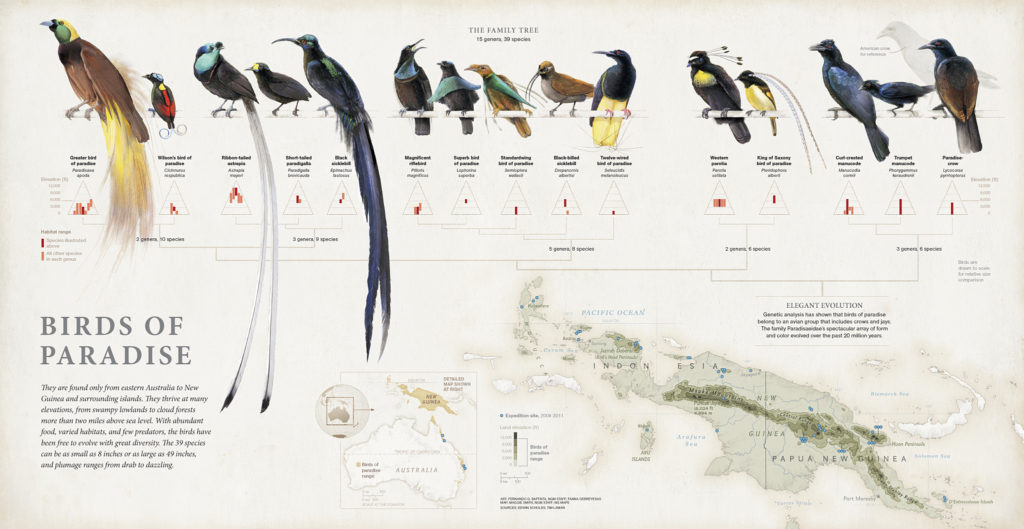
These Birds-of-Paradise are known for their colourful, long and elaborate feathers and fascinating courtship dance performances. In these mating rituals that always occur in the same place known as a lek, males will repeatedly jump from one branch to another or hang upside down to show off their lovely tail plumes. However, within the Paradisaeidae family there is significant diversity with not all species exhibiting these traits and behaviours. Of all the species, 35 are polygamous and tend to have elaborate feathers and dance rituals, while the remaining few are monogamous and are less colourful (3).
Among the most notable of the Birds-of-Paradise are the plumebirds (4) – the seven species of Paradisaea sp. This grouping includes the famous Greater Bird-of-Paradise (Paradisaea apoda), the largest bird within this group who dons the notable white and yellow tail plumage. Another notable species is the Superb Bird-of-Paradise (Lophorina superba) which has an incredible spreading breast shield and a cap that turns into a head-fan.
The five species of the long-tailed Birds-of-Paradise, genus Astrapia, are also an incredible sight – the males have shining black, iridescent feathers and long graduated tails of black and white feathers that can total in length of 31 to 45 inches (80-115cm).
Another stunning group are the riflebirds, with their shimmering metallic neck feathers of turquoise. They were named so as they somewhat resembled an early-day British rifleman’s uniform and some of the species call is like the prolonged ‘hiss’ of a bullet soaring through the air (5).
The first Bird-of-Paradise skin to reach Europe is thought to have been in 1522 and it wasn’t long until the demand for more of these illustrious birds took hold (6). By the late 19th century, despite many Birds-of-Paradise being on the way to decimation, the feather trade for Europe’s elite continued even until the early 20th century where approximately 50,000 birds were being hunted each year (7). Many still remain threatened today due to hunting and habitat loss.
Bird of Paradise Symbolism and Meaning
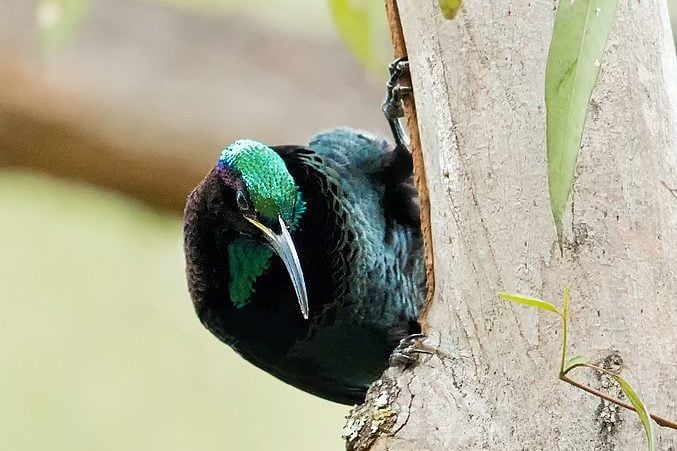
The most extraordinary and the most beautiful of the feathered inhabitants of the earth — Alfred Russel Wallace, 19th Century Naturalist (8)
With Papua New Guinea home to all but a handful of the Bird-of-Paradise species, the development of symbolic meaning begins there and has traveled around the world ever since Europeans discovered their beauty in the highland jungles.
A dedication to beauty and extravagance in their courtship dance rituals has evolved in many of these species. Giving the Birds-of-Paradise the symbolic connection to an elaborate and even sometimes vain performer. Some dance in trees while others create a stage on the forest floor by stripping away any upper foliage so the sun can shine like a spotlight on them. The males are not shy to compete with each other – some even dance on logs together. They create a group spectacle designed to help the females compare and choose their most attractive bachelor!
For some, the glistening, exotic feathers have conjured up associations of the luxuries in life:
“Birds of paradise glisten like seldom glimpsed denizens of an Asiatic harem, who are clad in gold of many hues and dipped in the purple of dawn.”––Thomas Forrest, The Breadtree Fruit, 1784
The male Raggiana Bird-of-Paradise has been especially important for Papua New Guineans, as it is incorporated in various cultural activities. Its plumes being used as ceremonial decoration and it is even depicted on their present day bank notes. Thus, people of many different cultures have felt the plumes of Birds-of-Paradise are symbolic representations of a variety of concepts including power, wealth and sexuality.
Bird of Paradise Native New Guinea Symbolism
Research on the symbolic meaning of the Bird-of-Paradise plumes in their indigenous context, has found consistently that they have been a measure of high status as well as with fertility across New Guinea (12).
Men from the Yonggom tribe of Papua New Guinea hunted the Greater Bird-of-Paradise for their feathers which they used to decorate ceremonial headdresses worn during ritual dances (13).
In the Papuan areas of Western New Guinea (Indonesia) and particularly amongst the peoples of the Maluku islands – off the coast of West Papua, accounts from very early European explorers indicate that people wore Bird-of-Paradise feathers on helmets or headdresses when going into battle. They believed that these plumes brought invulnerability and invincibility to the warriors who wore them. Even the courtship dance of the Greater Bird-of-Paradise was referred to by these native peoples as ‘cakalele’ which translates to ‘war dance’ (14).
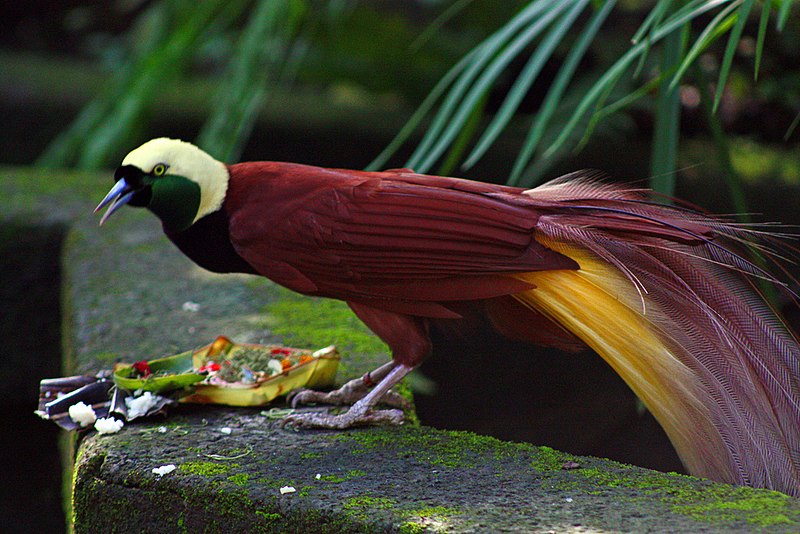
Other explorers have since described Malukan and Papuan festivals where traditional dances involved warriors wearing elaborately feathered headdresses, rhythmically leaping around to mimic a cakalele with a spear or sword. Thus, there is a merging in the cultural symbolism of the Bird-of-Paradise mating dances and the native people’s war dances in both traditional activities and in vocabulary.
Bird of Paradise European Symbolism
For Europeans, the Birds-of-Paradise that came from the colonial states, were a symbol of elegance, exoticism, status and wealth. Their skins and feathers were prized possessions and were used primarily in women’s fashion. They were used to adorn lady’s hats, especially the longest and most elaborate tail feathers which would have produced a great deal of awe and envy amongst the other elite women of the times .
Bird of Paradise Christianity Symbolism
A Catholic Bishop in the latter part of the 16th century, when myths of these Birds-of-Paradise were travelling like wildfire across Europe – identified the metaphor of the way in which these birds were said to exist and reach their death. He asserted that these birds showed the fate of sinners who, in falling from God’s grace, plummeted from the skies to their death. People believed these stories and the birds became known as ‘Birds of God’ which resided in a Heavenly Paradise until death (16).
Bird of Paradise in Dreams
A dream about a Bird-of-Paradise can mean that within your inner psyche there is a building energy of excitement and even quirkiness (17). This sense of elation may be from recently receiving positive energy from an admirer, or an upcoming social event that has got you ruffling your feathers – in a good way!
You’re feeling somewhat unpredictable and fanciful with a readiness to put yourself out there for others to see. You may have been putting a lot of energy into your physical appearance lately that has got you feeling pretty flash.
This may all be a bit unusual for you but could mean that you’re maturing in an unexpected direction, testing your own waters and seeing where new relationships will take you. This Bird-of-Paradise in your dreams may be a messenger suggesting to reflect on what traditional rituals are important to you and reminding you of your cultural foundation – especially in the realm of finding meaningful relationships – whether that be one or many!
Bird of Paradise in Mythology & Folklore
Tales of the Birds-of-Paradise have traveled across the world – from their native lands in New Guinea and surrounds, to other parts of Asia, Europe and beyond! A strong linkage between these folklore and mythical stories is the connect that these birds have to the realm of Gods in the heavens. They have been used to explain and strengthen existing religious beliefs and were thought to possess powers to bring good luck.
Native New Guinea Mythology
The many Birds-of-Paradise found on these lands have for millennia played important roles in stories and ceremonies of native peoples. They feature prominently in local myths as ancestors and as clan totems. It is told that people consider their family members to be birds-of-paradise and hold a profound life force energy (18).
One New Guinea story is told by an anthropologist who spent more than a decade living with tribal people in the region. The local tale is of a girl who places the body of her brother in the hollow of a tree. As she strikes the tree, Birds-of-Paradise explore upward like smoke and downward like fire – representing both the darkness of highland birds and the vividness of the lowland species. The significance of these birds of tribal New Guineans is of the flight of the spirit as well as symbolising birth (19).
For Papuans, these birds were also creatures of the sky realms. It was said that when a bird was ready to leave life on this earth, they flew directly into the sun until they became exhausted and simply fell down to the earth and died .
European Mythology:
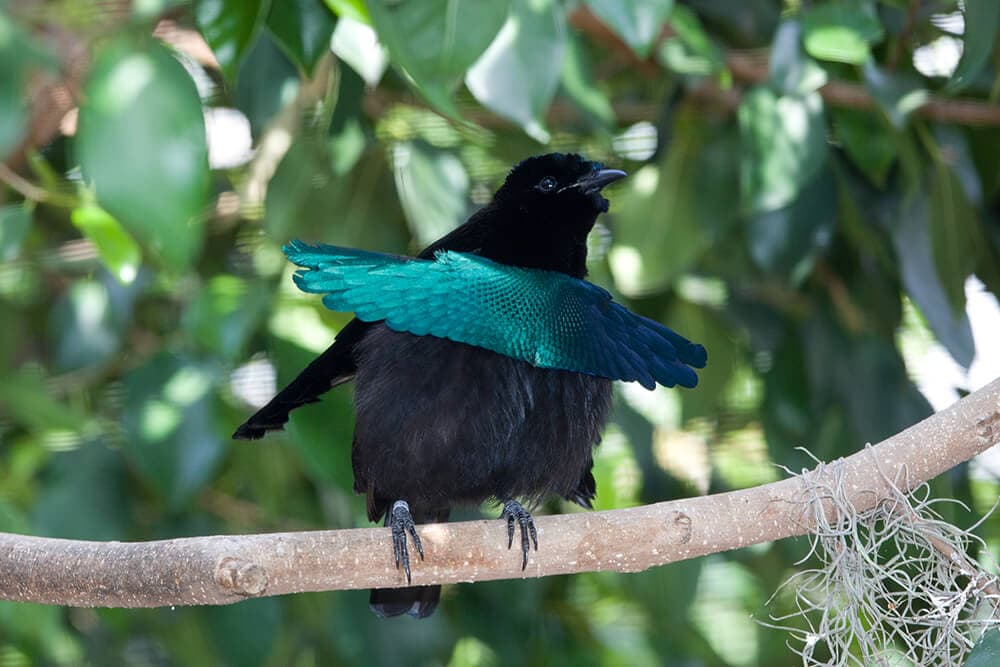
Their incandescent plumage and exotic origins gave rise to incredible stories in Europe of the habitats from which these birds have come and the people who reside there. It was accepted that feathers with such a variety of mesmerising colours and shapes could only be found on birds from an imaginary land.
With the arrival of Birds-of-Paradise to Christian European countries, tales of their heavenly origins were abound. They captured the imaginations of people because they were transported from New Guinea without their feet and often without wings – the native’s method of preserving the body. This unusual physicality gave rise to the story that these birds were from Paradise and flew in the air without rest, subsisting on dew and nectar and never came back down to earth until they eventually died. The knowledge that these birds had descended from the heavens or from an earthly paradise was traveling across Europe and was furthermore encouraged with the translation of the Malay name used in some of these locations – Manuqdewata – meaning ‘Birds of the Gods’.
Christian Mythology:
Stories took on a religious connotation when even a medical authority of the 16th century proclaimed that these birds floated effortlessly in the skies and consumed only heavenly dew. A Catholic Bishop in the latter part of the same century asserted that these birds were clear representations of the fate of sinners who, in falling from God’s grace, plummet from the skies to their death. People believed these stories so strongly that the birds came to be known as ‘Birds of God’ or ‘Divine birds’ .
In support of this mythical tale is a painting from 1617 by Bruegel the Elder and Rubens of Adam and Eve depicted in Paradise. Here the birds do have their feet, symbolizing that these birds are otherworldly creatures who have no need to have feet to walk on this earth (23).
Middle East and Far East Mythologies:
Exposure to Birds-of-Paradise has been occurring throughout Asia through trade routes for potentially thousands of years. As such, diverse cultures across the region have developed their own tales and symbolisms of these majestic birds. It was these rainbow-plumed creatures that inspired the legend of the Birds from Paradise that were perched in the Tree of Life – a symbol that spans cultures and continents. This bird of god was known not to have feet nor wings and used its elegant tail feathers to hang from trees. In the Far East, these birds dropped their eggs from the tree onto the ground, from which a full-grown bird emerged (25).
In the ancient culture of Persia, the Bird-of-Paradise was called the Huma and blessed those who could touch it with good fortune. If someone was lucky enough to have one perch on their head, they were believed to be destined to be a king or great leader. Huma symbolised the harmonious coming together of the male and female represented by a wing and a leg, respectively (26).
Bird of Paradise Spirit Animal
There are myriad ways that a Bird-of-Paradise may enter into your life and field of awareness. If they have found you it surely means that you are ready for a bit of colour, vibrancy and excitement in your life (27). You may have been feeling a dullness of energy, uninspired and needing a little sparkle. If you’re wanting to be noticed by someone special, the new Bird-of-Paradise in your world will be bringing you this rainbow boost! But remember, these shifts may take their time, and you may not be able to catch the eye of another on the first try. Perseverance, honesty and faith in ritual are all attributes of the Bird-of-Paradise spirit animal that will mature your radiant shine.
This bird spirit is heavy with masculine energy and may be brought forth to those who need to recalibrate their own internal balance. The Bird-of-Paradise spirit may have appeared for you if it knows you’re needing to unlock an abundance of masculine potential. Whether you need to assert yourself in a situation, feel confident in your skills and abilities or gather power for your ‘battles’, this spirit animal has appeared for you to shine a light on your strengths.
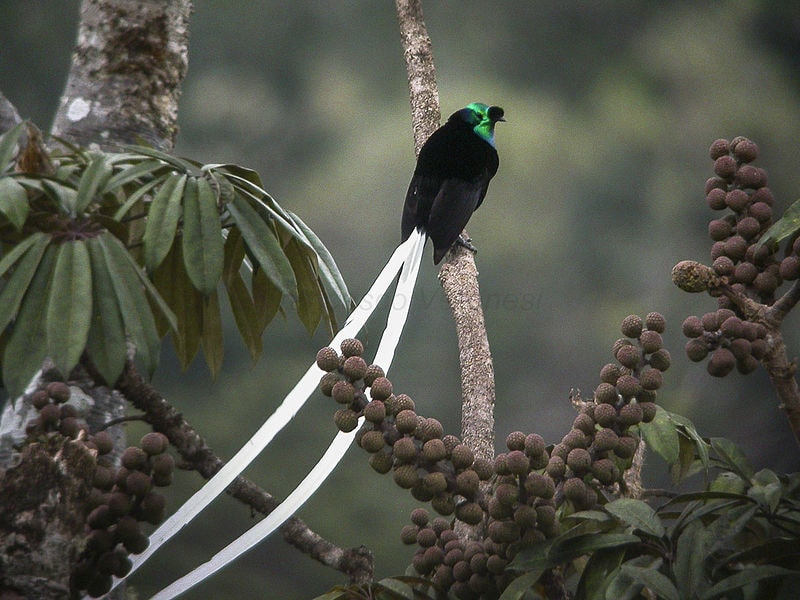
Bird of Paradise Totem Animal
If you have a Bird-of-Paradise as your totem animal, you’re going to be exceedingly vibrant, adventurous and likeable. You easily draw attention to yourself and so often are the creator of big dreams and big plans. You have a natural persuasiveness because of your confidence and appealing personality. Despite this, you do not stray towards manipulating others. Rather you strongly value honesty. But even with your good intentions, this can be confronting for some when they get a piece of your mind! Although friendly as can be, Bird-of-Paradise people can be highly polarising characters (28).
Bird-of-Paradise people are imaginative and hard working. And with all this confidence and attention, they will chase a dream to the ends of the Earth – which is exactly where explorers seemingly had to go to find them! Generally, Bird-of-Paradise people do reap a lot of rewards in their chosen careers, which are often within performance-type roles such as a musician, actor or dancer. For these people, it is critical that they keep their intentions in perspective as they can easily get carried away and end up on the opposite side of the earth than they may need to be! (29)
They are not jealous in their romantic relationships and often find themselves in many, even simultaneously! They are free spirited with their lovers and so are not hypocritical but prioritise honesty and equality (30). All the success that people with this birth totem find themselves, may not however enter into the realm of long term relationships. These people do not relish the thought of settling down and may lean towards prioritising the attractiveness of a mate over their potential for a genuine, stable relationship. If the Bird-of-Paradise does want to settle down and create a family, they may need to scale down their big dreams and reshuffle their priorities in this arena of life (31).
Bird of Paradise Power Animal
If you have been feeling a dullness of energy, uninspired and needing a little sparkle – if you’re wanting to be noticed by someone special, it might just mean that you need a little Bird-of-Paradise in your world to bring you the electric rainbow boost you need!
This power animal can be of assistance if you feel torn between multiple romantic relationships (32). The Bird-of-Paradise is a master of knowing their true feelings and being open and honest to others. This spirit guide can support you in eradicating jealousy from yourself and others you’re in partnership with.
This bird spirit will bring you a strong dose of masculine energy and may be summoned forth when you need to recalibrate your own sacred internal balance. If you are in need of the vigour to assert yourself, flaunt yourself, show courage and strength – this power animal will be of service to you.
Bird of Paradise Tattoo Meaning
A Bird-of-Paradise tattoo is a literal representation of timeless beauty. These birds have been admired across the world for thousands of years for their dazzling array of colours and unique courtship dances.
People native to New Guinea and surrounding islands have used the bird’s plumes in ritualistic ceremonies that connect them to nature, to their ancestors and to prepare them to be courageous for battle. Termed by native peoples and Europeans ‘Bird of the Gods’, these birds have an ethereal connection and are thought to have literally descended from the heavens.
Altogether these birds symbolise power, exotic beauty, connection with the celestial realms and masculine energy utilised to persevere with your inner resolve to live life to the fullest! (33)
Conclusion
Birds-of-Paradise have an exceptionally interesting history. They have been revered in their homelands of New Guinea in Southeast Asia and Oceania for thousands of years, symbolising courage, fertility and the ancestral spirit realms. More recently they were brought to Europe where their allures were principally aesthetic but also where they took on a mythologised character of being from the heavenly realms.
People who make a connection with the Birds-of-Paradise are to be blessed with great strength and a renewed vigour for life, for relationships and for garnering the attention you deserve!

